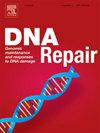PrimPol介导的斥责可通过模板切换引起间隙填充,并促进细胞对西多福韦的耐受性。
IF 2.7
3区 生物学
Q2 GENETICS & HEREDITY
引用次数: 0
摘要
核苷类似物西多福韦(CDV)用于治疗巨细胞病毒视网膜炎和疱疹病毒感染等病毒性疾病。CDV 通过细胞激酶转化为其活性二磷酸代谢物(CDVpp),成为病毒聚合酶的竞争性抑制剂,从而干扰病毒复制。然而,这种药物对健康宿主细胞复制的影响以及细胞对 CDV 的耐受机制尚待充分了解。在这项研究中,我们从一系列缺乏各种基因组维护系统的 DT40 突变体中筛选出了对 CDV 表现出超敏反应的突变细胞系,从而探索了细胞耐受 CDV 的机制。我们发现Rad17和PrimPol是CDV耐受性的关键因素。我们发现,Rad17 在通过磷酸化 Chk1(一种重要的检查点介导因子)激活 S 期内检查点方面起着关键作用。我们发现,参与释放停滞复制的因子PrimPol与Rad17一起在CDV耐受中发挥关键作用。我们发现,与野生型细胞相比,PrimPol 缺陷细胞在 CDV 导入的模板链上的复制速度更慢,这表明 PrimPol 在 CDV 导入的受损模板上的持续复制叉进展中起着关键作用。PrimPol通过其DNA损伤旁路功能和斥责功能释放复制停滞,因此我们利用PRIMPOL的分离功能突变基因研究了PrimPol的哪种功能参与了CDV耐受。PrimPol缺陷细胞的CDV超敏表型通过PRIMPOLY89D(引物酶活性/聚合酶活性降低)得以恢复,这表明PrimPol的斥责功能是在CDV损伤模板上维持复制所必需的。此外,我们还发现,PrimPol缺陷细胞中姐妹染色单体交换(SCE)的数量减少了。这些数据表明,PrimPol 在 CDV 破坏的模板上介导的修复所产生的间隙通过模板切换促进了复制后的间隙整理。本文章由计算机程序翻译,如有差异,请以英文原文为准。
PrimPol-mediated repriming elicits gap-filling by template switching and promotes cellular tolerance to cidofovir
A nucleoside analog, Cidofovir (CDV), is used for the treatment of viral diseases such as cytomegalovirus retinitis and herpes virus infection. CDV converts to its active diphosphate metabolite (CDVpp) through cellular kinases and acts as a competitive inhibitor for viral polymerase thereby interfering with viral replication. However, the effect of this drug on the replication of healthy host cells and the mechanisms involved in the cellular tolerance to CDV are yet to be fully understood. In this study, we explored the mechanisms underlying cellular tolerance to CDV by screening mutant cell lines exhibiting hypersensitivity to CDV from a collection of DT40 mutants deficient in various genome maintenance systems. We identified Rad17 and PrimPol as critical factors for CDV tolerance. We found that Rad17 plays a pivotal role in activating intra-S phase checkpoint by the phosphorylation of Chk1, a vital checkpoint mediator. We showed that PrimPol, a factor involved in the release of stalled replication, plays critical roles in CDV tolerance in tandem with Rad17. We found that PrimPol deficient cells showed slower replication on the CDV-incorporated template strand than did wild-type cells, indicating a critical role of PrimPol in the continuous replication fork progression on the CDV-incorporated damaged template. PrimPol releases replication arrest with its DNA-damage bypass function and its repriming function, we thus investigated which PrimPol function is involved in CDV tolerance using the separation of function mutant genes of PRIMPOL. The CDV hypersensitive phenotype of PrimPol deficient cells was restored by PRIMPOLY89D (primase active / reduced polymerase activity), indicating that the repriming function of PrimPol is required for maintaining replication on the CDV-damaged template. Moreover, we found that the number of sister chromatid exchange (SCE) was reduced in PrimPol-deficient cells. These data indicate that gaps generated by PrimPol-mediated repriming on CDV-damaged templates promote post-replicative gap-filing by template switching.
求助全文
通过发布文献求助,成功后即可免费获取论文全文。
去求助
来源期刊

DNA Repair
生物-毒理学
CiteScore
7.60
自引率
5.30%
发文量
91
审稿时长
59 days
期刊介绍:
DNA Repair provides a forum for the comprehensive coverage of DNA repair and cellular responses to DNA damage. The journal publishes original observations on genetic, cellular, biochemical, structural and molecular aspects of DNA repair, mutagenesis, cell cycle regulation, apoptosis and other biological responses in cells exposed to genomic insult, as well as their relationship to human disease.
DNA Repair publishes full-length research articles, brief reports on research, and reviews. The journal welcomes articles describing databases, methods and new technologies supporting research on DNA repair and responses to DNA damage. Letters to the Editor, hot topics and classics in DNA repair, historical reflections, book reviews and meeting reports also will be considered for publication.
 求助内容:
求助内容: 应助结果提醒方式:
应助结果提醒方式:


